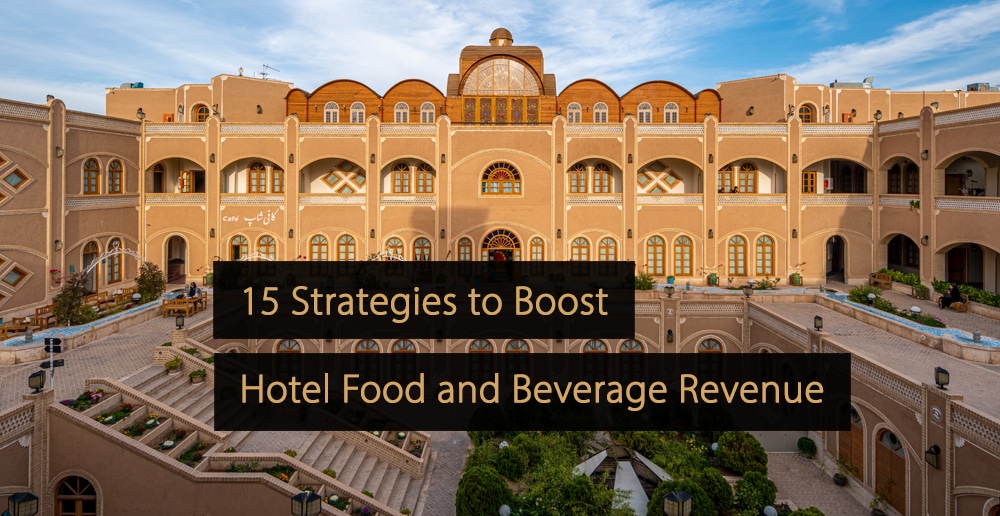Managing hotel restaurants may be challenging. Ultimately, one might say maintaining a hotel as a whole is likely enough effort in and of itself, not even to mention trying to figure out how to ensure the hotel restaurant operates to its fullest potential. However, in the long run, it pays to consider ways to boost F&B (food and beverage) sales in your hotel restaurant.
15 Strategies to Boost Hotel Food and Beverage Revenue
Below you will find 15 effective strategies to help you increase F&B sales at your hotel.
Ready? Let’s jump right into the list below.
1. Improve Your Guest Experience
Although it sounds fairly simple, you would be amazed at how little attention hotels give to this part of the industry. But, providing excellent customer service is one of the most crucial ways to win over and keep guests.
A quality service entails reviewing guest comments and utilizing that data to alter and enhance your food and overall experience. Not to add the way you presented yourself, how well you served your guests, and how pleasant it was to be there.
All of this makes sure that your guests enjoy, not endure, their dining experience!
Implementing straightforward guidelines for staff to welcome, assist, and serve guests will encourage guests to visit your restaurants more frequently, increasing revenue.
To help take your guest experience to the next level, hotel owners can also consider integrating their PMS (Property Management System) with their restaurant’s TMS (Table Management System). For example, by connecting Eat App with your PMS, hoteliers can centralize the entire guest journey.
A key component to help elevate the guest experience. This means that staff can identify which restaurant guests stay at the hotel and who only visit for the day. Other benefits include retargeting hotel and non-hotel guests with special offers to get them to come back for more.
2. Enhance Your Menu with Healthier Options
As technology advances, our understanding of nutrition continues to expand. Additionally, with the invention of the internet, individuals are more aware of what they put in their bodies and on their plates.
As the expression says, your body is a temple, and many guests are becoming more health-conscious. Including healthier options on your menu may appeal to a wider (guest) audience and draw in more diners. Think of foods that might also be suitable for vegans or vegetarians.
If you don’t already, consider making nutritional data available to guests. Due to the increasing importance of sensitive diets in some people’s life, these are becoming more crucial. Restaurant guests will value that you’ve taken care of these things.
To help you achieve the above, invest in a revolutionary reservation system, where guests can book online and note their specific food preferences. This will help your kitchen, and your restaurant staff at the hotel get ready and prepare before the guests arrive.
3. Publicize Each Restaurant Section Separately
If there are several locations in your hotel where guests can purchase food and drinks, then it makes sense to give each one a unique name and market it separately. This covers many social media and marketing initiatives and various design ideas for each of them.
For instance, a hotel’s bar, cafe, and restaurant should all operate as three distinct spaces. This is a great approach to provide the impression that the hotel is unique and to give the consumer the impression that they might enjoy a variety of experiences at your hotel.
4. Exclusive Discounts for Loyal Guests
Offering regular guests special discounts is a terrific way to get them to return to your hotel whenever they’re nearby. When choosing between two hotels, something as straightforward as offering a free dessert to a repeat guest may be sufficient to influence their decision.
Additionally, the guest feels like they are getting special care and a reward for their devotion to the restaurant and hotel, which helps the business build a relationship with them. This creates a string of regular guests, or even “superfans”, who frequent your dining establishments, increasing income.
An advanced CRM system allows restaurants to filter, segment, and tag customers by the data collected by their table management system. After guests are segmented, staff can easily deliver personalized marketing messages (for example, special offers) from within the database. In this case, investing in a restaurant CRM system can be extremely useful.
5. Make F&B Accessible Around the Property
Even though a hotel’s restaurant may be said to be its culinary center, many guests prefer to get their food and drinks elsewhere on the property.
In light of the fact, according to Statista, recent years have seen a fall in hotel food and beverage sales. The need for hotel food and beverage sales must undoubtedly increase to appeal to a rising clientele who prefers to eat in various settings.
6. Greater Food and Beverage Sales Result from Easy Online Ordering
In your hotel, there are fewer obstacles to obtaining food and drink. Therefore, making ordering for guests straightforward will encourage them to place more orders.
Convenient ordering technology makes it much easier to make extra money by luring guests who prefer not to wait until set meal times or who would be discouraged from driving to the restaurant to get some food. For example, why take a chance at losing that seat near the pool?
7. Learn About the Science of Menus
It’s good to note, while creating a menu, we can’t just slap everything onto a card with fancy fonts and cross our fingers. To prepare a menu, it is essential to research information on how to lay out the food items, what typefaces to use, and what size the print should be.
Create a menu that encourages guests to choose more expensive meals while providing them with a wonderful dining experience. Examine your meals in light of recent orders, popularity, and the locations and times when they are placed. This can be compared to profit margins. Look for themes and consider how you may capitalize on these developments.
8. Fast and Effectively Increase Food and Beverage Sales
The saying “time is money” has never been more applicable than it is in today’s fast-paced world.
Waiting for one’s food to be made and served is one of the things one cannot waste a lot of time on in such a world. If the lodgings in your restaurant offer quick service, you will automatically have an advantage over most of your rivals.
People value prompt restaurant service. They are more likely to return to a restaurant with quick service than one that makes them wait excessively long. As a result, quicker service will bring in more clients, have tables change over more quickly, and ultimately increase income.
9. Do Your due Diligence with Respect to the Data
Obtain details about your establishment. Take a look at the busiest time of day. What are the season’s most favored months? Understanding daily, monthly, and seasonal fluctuations are essential to your hotel restaurant’s profitability. At those times, what do guests order most frequently?
This data can generate creative ideas for enhancing the visiting guest’s experience. Spreading the word is also made easier by keeping it current and relevant. This raises the likelihood of them returning.
10. Increase Your Seating Availability
This one is fairly easy. It’s simple math: the more seats you have, the more patrons you can serve.
Hire an interior designer to help you arrange the tables so you can serve as many clients as possible. It’s a practical approach to boost food and beverage sales at your hotel and comparatively simple to put into practice.
Another great way to maximize your seating availability is to invest in a revolutionary table management system to help you improve your table turnover rate.
The following are a few effective ways that a table management system can help you speed up your table turnover rate:
Personalized floor plan feature: A table management system enables you to alter and update your floor plan in real time, which helps your team more quickly comprehend the state of the floor.
Online booking system: Simplified and convenient online booking procedures make it easier for guests to make reservations, which helps hotel restaurants be more ready for forthcoming shifts.
Service effectiveness: Table management solutions give your personnel access to guest data, such as preferences, previous visits, etc., before the visitors even enter the building. This makes it simpler for them to serve the diners effectively and efficiently.
Advanced reports: Most table management programs also have comprehensive reporting features that enable operators and hotel owners to understand their establishment’s performance better and take appropriate measures to reduce table turnover rates.
Operational effectiveness: Table management systems allow for a coherent management experience, ultimately leading to streamlined operations and increased table turnover rates. This is made possible by having one centralized system for managing the entire hotel restaurant.
11. Aim for the best possible room service
It’s okay if some folks don’t want to leave their rooms. Although they may not leave their room, this shouldn’t prevent you from maximizing your hotel’s food and beverage sales.
Give your visitors the best possible room service. It’s crucial to ensure that your in-room service is as elegant as your restaurant service. It will entice visitors to place orders from their rooms, boosting your earnings. The additional expenses incurred will be offset by repeat visitors and word-of-mouth recommendations.
12. Offer Flexible and Amiable Pricing
Your charges should be in line with the sophistication of your clientele. They will choose another option if it costs more than they usually spend.
Restaurants should always be aware of the typical spending limits of their patrons as well as the costs other restaurants are charging for comparable food and drink to stay competitive.
13. An Excellent Restaurant Appears Modern
Restaurants are no exception to the rule that if you don’t change with the times, the times will change ahead of you.
Guests will be encouraged to try new things with an up-to-date menu with frequent updates and popular trends. Your restaurant will gain the reputation of being one that never stops trying to innovate and improve.
In this case, it’s also recommended to ditch the pen-and-paper method and offer hotel guests a convenient way to book at your restaurant via your online channels. This can quickly be done with a revolutionary reservation platform.
14. Not all MealsRequire Three Courses
The fact that not everyone has the time or appetite for a full three-course meal is a minor but significant consideration. As a result, individuals looking to grab a fast bite should have options.
Small lunch bits or breakfasts to go can be something that would be successful and boost your restaurant’s food and beverage sales.
15. Sustain Your Positive Hotel Rating
Most hotel owners know the requirements they have to meet to receive their official star rating. The important thing is to keep your hotel restaurant ranking at the top. This is particularly relevant to the menu and service at your restaurant. You may avoid being complacent about your ratings by implementing routine requirements for your hotel.
If at all possible, think about aiming for the next rating. This is a worthwhile objective for your team to pursue and a different way to raise food and beverage sales at your hotel.
Got it? By implementing the strategies from this complete guide, you’ll begin to boost revenue from your hotel’s food and beverages.
Free Guide: Learn How to Triple Your (Hotel) Restaurant Revenue
In this restaurant Customer Acquisition guide, you’ll learn how to increase online reservations on multiple platforms like Google Business, Facebook, and Instagram. This way, you reach a large audience and increase the number of reservations.
Click here to download the “Restaurant Customer Acquisition Guide”.
More Tips to Grow Your Business
Revfine.com is the leading knowledge platform for the hospitality and travel industry. Professionals use our insights, strategies, and actionable tips to get inspired, optimize revenue, innovate processes, and improve customer experience.Explore expert advice on management, marketing, revenue management, operations, software, and technology in our dedicated Hotel, Hospitality, and Travel & Tourism categories.








Leave A Comment